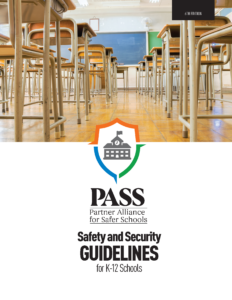Celebrate Safe Schools Week With a Preview of Our Revised Guidelines
This week, October 16–22, schools across the nation are observing Safe Schools Week.
The National School Safety Center launched the week-long commemoration in 1984. It draws the attention of students, school personnel, first responders and community members. It’s also supported by public officials and professional organizations. It’s a time to recognize the work done to improve school safety and security and reflect on the long road ahead.
As you commemorate the week by learning more about school safety, we’re excited to offer a preview of our newest, sixth edition of the PASS Guidelines. The PASS Safety and Security Guidelines and School Safety and Security Checklist are how we promote school safety year-round. Every two years, with students and school personnel in mind, we examine them closely to ensure they reflect the best industry standards and practices.
“The PASS Guidelines are essential to our mission of providing school officials, public safety personnel and security professionals with the information, tools and insight needed to develop and implement effective safety plans on school campuses in their communities,” said Scott Lord, spokesperson for the PASS Advisory Council’s Technical Committee. “We understand the importance of the work we’re doing, and we’re committed to getting it right.”
Our Guidelines and Other Resources
Founded in 2014, the Partner Alliance for Safer Schools (PASS) brings together education, public safety and security industry experts to assist K12 schools in developing a coordinated approach to effective practices. Our resources are tools for objective analysis. School officials and other experts often use them to assess and prioritize school safety and security measures.
The PASS Guidelines focus on providing a multi-layer tiered approach to school safety and security. With the guidelines, schools have comprehensive and valuable tools to measure their adherence to the latest safety and security protocols. Our guidelines can also help them adopt appropriate and effective solutions to both common and unique challenges.

“We understand the importance of the work we’re doing, and we’re committed to getting it right.”
—Scott Lord, spokesperson, PASS Advisory Council’s Technical Committee
Summary of Sixth Edition Updates
This year marks the sixth edition of our PASS Guidelines. Our latest updates are strategic and intentional. They will guide you in developing a safe school plan, crime prevention tactics, staff training and a crisis preparation plan. Plus, you’ll gain insight into increasing involvement from students, parents, school board members, staff, local law enforcement and community members.
Update: PASS Safety and Security Checklist
In response to school personnel feedback, we streamlined the PASS Safety and Security Checklist to improve ease of use.
“One concern we’ve heard from schools that have adopted the PASS Guidelines is that it was a bit overwhelming to reach Tier One,” Lord said. “With this update, we’ve reduced the number of items to achieve Tier One status by almost 50%.”
New Section: Prerequisite
The new Prerequisite section captures much of the information removed from the Safety and Security Checklist. Now in summary form, the section details what all schools should do regarding policy and procedure. The Cybersecurity section also moved to the Prerequisite. Most of what PASS previously established there is now standard practice in schools today, Lord said.
New Section: Enhanced Safety Technology
The Emerging Technologies section is now Enhanced Safety Technology. This section is for school districts and highlights physical school security-related technology recommendations that are serious, but not required.
For example, vape detection is a form of enhanced safety technology. Vaping is an issue for schools and a student health concern. However, vape detection technology isn’t necessarily required to secure schools, Lord said. Other examples of technologies in this section include video analytics, facial recognition and advanced artificial intelligence analytics.
Observe Safe Schools Week and Put the Guidelines to Work On Your Campus
The National School Safety Center recognizes that “while most schools have existing safety programs, these programs often need conscientious, creative application to improve their effectiveness.” PASS agrees.
This Safe Schools Week, be sure to sign up for our email updates. You don’t want to miss news about the upcoming sixth edition release. With the updated guidelines and your school security measures, you can begin to assess the state of safety and security measures on your campus or in your district. You can also compare them against national best practices.
Thanks to our volunteer contributors and PASS Partners, our PASS Safety and Security Guidelines will remain free to download.
Contributors: PASS thanks the PASS Advisory Council and Board of Directors for leading the review process for the sixth edition of the PASS Guidelines.
The Partner Alliance for Safer Schools (PASS) is a nonprofit 501(c)(3) bringing together expertise from the education, public safety, and industry communities to develop and support a coordinated approach to making effective and appropriate decisions with respect to safety and security investments. You can download the complete PASS Guidelines or check out our PASS Safety and Security Checklist for quick tips on how to get started. These resources—as well as whitepapers on various topics including barricade devices, lockdown drills, and more—are available at no cost.
Categories
- Access Control
- Classroom Door Locks
- Crime Prevention Through Environmental Design
- Cybersecurity
- Duress Alarm
- In the News
- Legislation
- Lockdown Drills
- New Technologies
- PASS Advisory Council
- PASS Board of Directors
- PASS Partners
- PASS Recommendations
- Preparedness
- Safe School Week
- Safety & Security Guidelines
- School Safety & Security
- Security Best Practices
- Video Surveillance

Ready to get the Guidelines?
The most comprehensive information available on best practices specifically for securing school facilities, vetted extensively by experts across the education, public safety and industry sectors.
